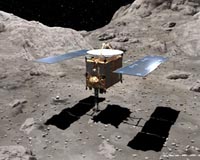 |
Pasadena, Calif. (UPI) Aug 24, 2010 NASA is getting ready for its Dawn spacecraft's encounter with a giant asteroid, set to happen in less than a year, the agency said. Dawn will conduct a detailed study as it spends a year circling the asteroid Vesta, becoming the first spacecraft to orbit a body in the solar system's asteroid belt, SPACE.com reported Tuesday. There have been previous missions to asteroids, but scientists say Vesta offers a chance for something special. "Vesta is going to amaze us," Marc Rayman, Dawn's chief engineer at NASA's Jet Propulsion Laboratory, said. At 350 miles across, Vesta is the second-largest body in the asteroid belt, containing almost 10 percent of the entire belt's mass. Only the asteroid Ceres, so large it is considered a dwarf planet, is a bigger belt object than Vesta. "It's a big, rocky, terrestrial-type body -- more likely similar to the moon and Mercury than to the little chips of rocks we've flown by in the past," Rayman said of Vesta. Scientists expect Dawn's mission will help them understand how planets form. Astronomers think Vesta was in the process of becoming a full-fledged planet when Jupiter interrupted its growth as the gas giant's gravity stirred up the material in the asteroid belt so objects there could no longer come together and coalesce. After a year orbiting Vesta, Dawn will move on to take a look at the only asteroid considered even more interesting, the dwarf planet Ceres.
Share This Article With Planet Earth
Related Links Asteroid and Comet Mission News, Science and Technology
 Japan plans second asteroid sample grab
Japan plans second asteroid sample grabTokyo (UPI) Aug 19, 2010 Japan will send another satellite on a mission to capture material from an asteroid and bring it back to Earth for study, scientists say. The Japan Aerospace Exploration Agency says a successor to the troubled Japanese spacecraft Hayabusa, which managed to return a capsule to Earth this year, could launch as early as 2104, NewScientist.com reported Wednesday. The cost of the new spacecr ... read more |
|
| The content herein, unless otherwise known to be public domain, are Copyright 1995-2010 - SpaceDaily. AFP and UPI Wire Stories are copyright Agence France-Presse and United Press International. ESA Portal Reports are copyright European Space Agency. All NASA sourced material is public domain. Additional copyrights may apply in whole or part to other bona fide parties. Advertising does not imply endorsement,agreement or approval of any opinions, statements or information provided by SpaceDaily on any Web page published or hosted by SpaceDaily. Privacy Statement |